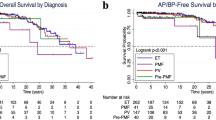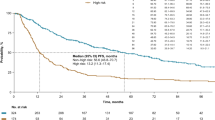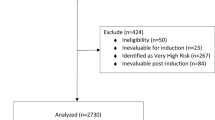Abstract
Although clinical improvement is almost universal with therapy in patients with POEMS (an acronym for polyneuropathy, organomegaly, endocrinopathies, monoclonal protein and a variety of skin changes) syndrome, outcomes and management of patients who relapse or progress (R/P) after first-line treatment have not been described. We retrospectively identified 262 patients with POEMS syndrome treated at the Mayo Clinic from 1974 to 2014 and who had follow-up information. The 5-year progression-free survival (PFS) and overall survival (OS) was 58% and 78%, respectively. Median time to R/P was 42 months. Seventy-nine patients (30%) had an R/P, with 52 (19%) experiencing a symptomatic R/P. Eighteen patients relapsed with symptoms or signs that were not documented at diagnosis. Median times to vascular endothelial growth factor, hematologic, radiographic and clinical R/P were 35 months (range, 4–327 months), 72 months (range, 4–327 months), 51 months (range, 4–327 months) and 48 months (range, 6–311 months), respectively. On multivariate analyses, low albumin at diagnosis and failure to achieve a complete hematologic response to first-line therapy were independent risk factors for PFS. Thirty patients had documentation of a second R/P at a median of 26 months from diagnosis of the first R/P. An early R/P was a risk factor for death, but most patients with an R/P had salvageable disease. A majority of patients are still without R/P at 5 years from diagnosis.
This is a preview of subscription content, access via your institution
Access options
Subscribe to this journal
Receive 12 print issues and online access
$259.00 per year
only $21.58 per issue
Buy this article
- Purchase on Springer Link
- Instant access to full article PDF
Prices may be subject to local taxes which are calculated during checkout


Similar content being viewed by others
References
Dispenzieri A . POEMS syndrome: 2014 update on diagnosis, risk-stratification, and management. Am J Hematol 2014; 89: 214–223.
Kuwabara S, Dispenzieri A, Arimura K, Misawa S, Nakaseko C . Treatment for POEMS (polyneuropathy, organomegaly, endocrinopathy, M-protein, and skin changes) syndrome. Cochrane Database Syst Rev 2012; 6: CD006828.
Dispenzieri A . How I treat POEMS syndrome. Blood 2012; 119: 5650–5658.
D'Souza A, Lacy M, Gertz M, Kumar S, Buadi F, Hayman S et al. Long-term outcomes after autologous stem cell transplantation for patients with POEMS syndrome (osteosclerotic myeloma): a single-center experience. Blood 2012; 120: 56–62.
Humeniuk MS, Gertz MA, Lacy MQ, Kyle RA, Witzig TE, Kumar SK et al. Outcomes of patients with POEMS syndrome treated initially with radiation. Blood 2013; 122: 68–73.
Jaccard A, Royer B, Bordessoule D, Brouet JC, Fermand JP . High-dose therapy and autologous blood stem cell transplantation in POEMS syndrome. Blood 2002; 99: 3057–3059.
Cai QQ, Wang C, Cao XX, Cai H, Zhou DB, Li J . Efficacy and safety of low-dose lenalidomide plus dexamethasone in patients with relapsed or refractory POEMS syndrome. Eur J Haematol 2014; 95: 325–330.
Royer B, Merlusca L, Abraham J, Musset L, Haroche J, Choquet S et al. Efficacy of lenalidomide in POEMS syndrome: a retrospective study of 20 patients. Am J Hematol 2013; 88: 207–212.
Katayama K, Misawa S, Sato Y, Sobue G, Yabe I, Watanabe O et al. Japanese POEMS syndrome with Thalidomide (J-POST) Trial: study protocol for a phase II/III multicentre, randomised, double-blind, placebo-controlled trial. BMJ Open 2015; 5: e007330.
Dispenzieri A, Kyle RA, Lacy MQ, Rajkumar SV, Therneau TM, Larson DR et al. POEMS syndrome: definitions and long-term outcome. Blood 2003; 101: 2496–2506.
D'Souza A, Hayman SR, Buadi F, Mauermann M, Lacy MQ, Gertz MA et al. The utility of plasma vascular endothelial growth factor levels in the diagnosis and follow-up of patients with POEMS syndrome. Blood 2011; 118: 4663–4665.
Watanabe O, Maruyama I, Arimura K, Kitajima I, Arimura H, Hanatani M et al. Overproduction of vascular endothelial growth factor/vascular permeability factor is causative in Crow-Fukase (POEMS) syndrome. Muscle Nerve 1998; 21: 1390–1397.
Hasenclever D, Diehl V . A prognostic score for advanced Hodgkin's disease. International Prognostic Factors Project on Advanced Hodgkin's Disease. N Engl J Med 1998; 339: 1506–1514.
Greipp PR, San Miguel J, Durie BG, Crowley JJ, Barlogie B, Bladé J et al. International staging system for multiple myeloma. J Clin Oncol 2005; 23: 3412–3420.
Dispenzieri A, Armitage JO, Loe MJ, Geyer SM, Allred J, Camoriano JK et al. The clinical spectrum of Castleman's disease. Am J Hematol 2012; 87: 997–1002.
Pan Q, Li J, Li F, Zhou D, Zhu Z . Characterizing POEMS syndrome with 18F-Fludeoxyglucose positron emission tomography/computed tomography. J Nucl Med 2015; 56: 1334–1337.
Yamada Y, Sawai S, Misawa S, Kanai K, Shibuya K, Mori M et al. Multiple angiogenetic factors are upregulated in POEMS syndrome. Ann Hematol 2013; 92: 245–248.
Scarlato M, Previtali SC, Carpo M, Pareyson D, Briani C, Del Bo R et al. Polyneuropathy in POEMS syndrome: role of angiogenic factors in the pathogenesis. Brain 2005; 128: 1911–1920.
Briani C, Fabrizi GM, Ruggero S, Torre CD, Ferrarini M, Campagnolo M et al. Vascular endothelial growth factor helps differentiate neuropathies in rare plasma cell dyscrasias. Muscle Nerve 2011; 43: 164–167.
Author information
Authors and Affiliations
Corresponding author
Ethics declarations
Competing interests
The authors declare no conflict of interest.
Additional information
Author contributions
Conception and design and data analysis and interpretation: Taxiarchis V Kourelis and Angela Dispenzieri; provision of study materials of patients, collection and assembly of data, writing of manuscript and final approval of manuscript: all authors.
Supplementary Information accompanies this paper on the Leukemia website
Rights and permissions
About this article
Cite this article
Kourelis, T., Buadi, F., Gertz, M. et al. Risk factors for and outcomes of patients with POEMS syndrome who experience progression after first-line treatment. Leukemia 30, 1079–1085 (2016). https://doi.org/10.1038/leu.2015.344
Received:
Revised:
Accepted:
Published:
Issue Date:
DOI: https://doi.org/10.1038/leu.2015.344
This article is cited by
-
Treatment and outcome of second-line therapy for POEMS syndrome after autologous stem cell transplantation
Bone Marrow Transplantation (2023)
-
Daratumumab, carfilzomib, and pomalidomide for the treatment of POEMS syndrome: The Mayo Clinic Experience
Blood Cancer Journal (2023)
-
POEMS syndrome: clinical update
Journal of Neurology (2019)
-
Prognostic study for overall survival in patients with newly diagnosed POEMS syndrome
Leukemia (2017)
-
POEMS Syndrome: an Enigma
Current Hematologic Malignancy Reports (2017)



